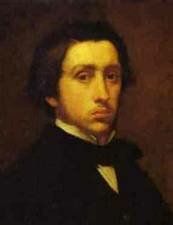 Edgar Degas19.07.1834 Paris - 27.09.1917 Paris Art history: ImpressionismCanvases of Edgar Degas [85 canvases]
Biography of Edgar DegasEdgar Degas was born into the family of bankers of aristocratic extraction. His mother died in 1847, so the boy's father, Auguste de Gas, and grandfather, Hilaire de Gas, were the most influential figures in his early life. Despite his own desire to paint he began to study law, but broke off his studies in 1853. He frequented F?lix Joseph Barrias’s studio and spent his time copying Renaissance works. In 1854-1859 he made several trips to Italy, some of the time visiting relatives, studying the Old Masters; he painted historical pictures and realistic portraits of his relatives: Portrait of Marguerite de Gas, the Artist's Sister. (1858-1860), Portrait of Achille de Gas in the Uniform of a Cadet. (1856-57), Portrait of Hilaire de Gas, Grandfather of the Artist. (1857) – 87 year-old head of the family. By 1860 Degas had drawn over 700 copies of other works, mainly early Italian Renaissance and French classical art. The most important historical work of the period was Spartan Girls Challenging Boys. (c.1860-62). It was exhibited only in 1879 at the fifth Impressionist show, and he kept it in his studio throughout his life. It was with a historical painting The Suffering of the City of New Orleans. (1865) that Degas made his salon debut in 1865. The picture got little attention. It must have seemed anachronistic and artificial: a medieval landscape setting and naked women bodies were used to symbolize the sufferings of the American city of New Orleans, which was occupied by Union troops in 1862 in the course of the Civil War. The Sufferings... turned out to be his last historical painting. In the troubled post-war years Degas undertook his longest journey. In 1872 with his younger brother Ren?, he traveled to New York and New Orleans, where his uncle, his mother's brother, Michel Musson, ran a cotton business. Degas stayed in Louisiana for 5 months and returned to Paris in February 1873. In America he fulfilled a number of works. Courtyard of a House in New Orleans. (1872) shows part of the Musson’s home in Esplanade avenue and possibly the room that served Degas a studio during his stay. The most important work resulting from his visit to the USA was Portraits in a New Orleans Cotton office. (1873). After his return from America, Degas had closer contact with dealers such as Durand-Ruel, in an attempt to bring his work to public attention independently of the Salon. In 1874 Degas helped organize the 1st Impressionist exhibition. He always found the term “Impressionism” unacceptable – mainly, perhaps, because he did not share the Impressionists’ over-riding interest in landscape and color. He did not care to be tied down to one method of painting. Nonetheless, Degas was to participate in all the group exhibitions except that of 1882. Degas used the group and the exhibitions high-handedly to promote himself. His strategy seems to have been to show off his own diversity at the exhibitions, for he always entered works that were thematically and technically very varied. Since late 1860s Degas frequently painted jockeys and race horses: Race Horses. (c.1866-68), Carriage at the Races. (1869). From 1870 he increasingly painted ballet subjects: Dance Class. (1871), Dancing Examination. (1874), The Star. (1876-77). Among other reasons they were easier to sell. Degas’ ballerinas have determined his popular image to his day. The rapid worsening of his eye condition caused him to avoid all society; he drew pastels, modeled statues in wax and extended his art collection. In 1909-1911, due to failing eyesight, he stopped work completely. After Degas’ death about 150 small sculptural works were found in his studio, and unsurprisingly his subjects tended to be race horses or dancers.
You can find canvases of this artist in these museums:
|
Для красивого отображения Облака Quick Search artists |
|||||||||||||||